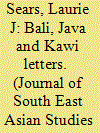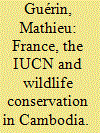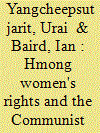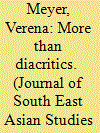|
|
|
Sort Order |
|
|
|
Items / Page
|
|
|
|
|
|
|
| Srl | Item |
| 1 |
ID:
188731


|
|
|
|
|
| Summary/Abstract |
I am not a specialist on Bali. I did live in Bali for more than a year in total over the past several decades, thus witnessing first hand its changing lifeways. I am a cultural and intellectual historian of Bali's neighbouring island of Java, and I carried out research on the central Javanese, specifically Solonese, shadow theatre in the early part of my career. I spent around five years in the city of Solo between 1972 and 1984, half of that time attending performances, and the other half hanging out with puppet masters, shadow theatre aficionados, and students of shadow theatre, and organising a project on collecting branch stories, stories that deviate from the trunk stories of the Solonese shadow theatre repertoire. The repertoire I was researching was the Javanese Mahabharata and Ramayana stories, a repertoire with which I was quite familiar. I was asked to be part of this special review to offer comparative insights between southern Balinese and central Javanese cultures from the point of view of the performing arts. From this perspective, I felt exhilarated to read Richard Fox's More than words and to read how literally alive Balinese letters, writ large and small, are in present-day Bali.
|
|
|
|
|
|
|
|
|
|
|
|
|
|
|
|
| 2 |
ID:
188733


|
|
|
|
|
| Summary/Abstract |
Over the years of studying the magical powers of words in the Burmese Buddhist context, I spent much of my research on the inner workings of the letter and phrase combinations and how the correct construction, combination and usage of these words, known in Burmese as inn, aing, and sama made for a potent prophylactic against a host of maladies. So focused had I been on the words that I had not taken the time to consider the individual letters, in and of themselves, before they went on to be combined into esoteric phrases and diagrams. Moreover, I had devoted my research to examining the ways Burmese words were predominantly seen to protect, purify, and even attack, but had never considered other ways in which letters may ‘do’ things, as Fox points out: namely, ‘represent cultural identity’; ‘embody and transmit knowledge’; ‘animate and enable’; ‘render things usable and so nameable’; ‘turn on their user’; and ‘both incur and pay debts’. While I cannot address each of these points in this short essay, I would like to discuss how Fox's book helped me to discover new ways of interpreting how letters and words may transfer their powers to people and things (‘embody and transmit knowledge’), as well as encouraging me to look into concepts of how, and if, letters can be considered ‘alive’ (‘animate and enable’) in the Burmese context.
|
|
|
|
|
|
|
|
|
|
|
|
|
|
|
|
| 3 |
ID:
188729


|
|
|
|
|
| Summary/Abstract |
Accounts of Buddhism in Thailand, Burma and Cambodia offer detailed descriptions of ‘the power attributed to inscribed amulets, tattoos, and related forms of writing’ (p. 8). But earlier scholarship on Southeast Asia ‘often looked down on non-literary uses of script’, treating it as either a ‘non-Buddhist “cultural” accretion or the ignoble trappings of popular superstition’ (p. 8). Such judgements were based on an idealised conception of Buddhism that focused on canonical scripture, and congealed under colonial rule. Where Richard Fox finds a fruitful ‘indeterminacy’ in the aksara of Bali, colonial scholarship tended towards overdetermination, creating a rigid hierarchy of Buddhist scriptural forms. Pali, the language in which generations of monks had chanted, thought and wrote, was deemed ‘less than’ Sanskrit, but ‘more than’ the plethora of indigenous languages of the region.
|
|
|
|
|
|
|
|
|
|
|
|
|
|
|
|
| 4 |
ID:
188724


|
|
|
|
|
| Summary/Abstract |
This article documents a significant and previously unknown episode in the history of Philippine labor, the explosive Manila Port Strike of the arrastre service workers—stevedores and longshoremen—in 1963. The strike was among the largest, costliest and most politically charged labor struggles in the nation's history and yet not only has no account of it been written, it has found no mention in over a half-century of historiography. Using confidential US State Department memoranda, contemporary newspaper accounts, Partido Komunista ng Pilipinas (PKP) publications, and material published by the Lapiang Manggagawa (LM), I reconstruct the history of the strike. This article examines how an event of this magnitude, while still part of living memory, could disappear from the historical record. The case of the 1963 Port Strike highlights the need to recover the histories of the oppressed by reading not only the official archives, but also the narratives of the workers’ own organisations, against the grain.
|
|
|
|
|
|
|
|
|
|
|
|
|
|
|
|
| 5 |
ID:
188728


|
|
|
|
|
| Summary/Abstract |
Richard Fox's More than words represents a sea change in the way we look at philology and textuality by decisively addressing a problem that was identified by George Lakoff and Mark Johnson in Metaphors we live by. In this work, Lakoff and Johnson developed the idea of conduit metaphors, the notion that thought is communicated by first being packaged and conveyed in script language and then unpackaged at the receiving end of communication. According to the conduit metaphor and its descendants and allies, there is an ineffable mental picture of thought, or thought as an ineffable presence in communication, that can be communicated across languages and cultural systems. While this idea has been expressed by different thinkers in different ways, in all variations of it, languages are conceived as a value-free tool for conveying a message. Some, like Walter Ong, tried to question this paradigm; but Ong's work on noetics ultimately also carried forth the old metaphor of script and language as a kind of packaging and thus did not provide us with a way to get beyond the conduit.
|
|
|
|
|
|
|
|
|
|
|
|
|
|
|
|
| 6 |
ID:
188722


|
|
|
|
|
| Summary/Abstract |
The history of wildlife conservation in Cambodia in the twentieth century reveals the tensions that existed between the Khmer kingdom and international nature conservation networks, colonial or global. Wildlife conservation in Cambodia was not a priority for the French colonial administration. It only regulated hunting. While the global conservation movement was expanding via international conferences, local French administrators managed to obstruct the implementation of a conservation policy. After the Second World War, Western scientists and activists sought to establish reserves, particularly to protect a new species of wild cattle, the kouprey. The International Union for the Conservation of Nature (IUCN), through the notable efforts of Harold Coolidge, succeeded in convincing Prince Sihanouk to adopt such a policy in the 1960s. However, although 12 per cent of the kingdom's land was protected, funding and means for conservation remained largely inadequate. The war put an end to all conservation programmes. The IUCN renewed its efforts in the 1980s successfully establishing a network of protected areas in Cambodia in 1993. The various twentieth-century Cambodian wildlife conservation policies, which all imposed external models, often without prior adequate field studies or involvement of local populations, have failed to prevent emblematic species from disappearing.
|
|
|
|
|
|
|
|
|
|
|
|
|
|
|
|
| 7 |
ID:
188719


|
|
|
|
|
| Summary/Abstract |
Between 1967 and 1969, thousands of Hmong in northern Thailand became aligned with the Communist Party of Thailand (CPT) and resided in mountainous strongholds near the border with Laos in Chiang Rai, Phayao, Nan, Phetchabun, and Phitsanulok provinces, and in Tak province near the border with Burma. They stayed in these strongholds until the early 1980s, when the CPT fell apart. During the CPT period, some important transformations in Hmong gender relations occurred, especially relative to the traditional strongly male-dominated society. We describe the most important changes, as reported by Hmong women. The legacy of the CPT period remains today. However, there has been some reversion to pre-CPT patriarchal practices. Some Hmong women feel nostalgic about the rights they enjoyed during the CPT period, although the leadership of the CPT was male dominated, and despite the fact that some progress has been made, for example, in convincing clan leaders to allow divorced women to return to their birth clans. This study applies a feminist geography and social memory theoretical framework to examine Hmong women's life stories about their time with the CPT.
|
|
|
|
|
|
|
|
|
|
|
|
|
|
|
|
| 8 |
ID:
188726


|
|
|
|
|
| Summary/Abstract |
This article examines the role played by commercial advertising in promoting images of city reconstruction and architectural modernity within Manila in the years immediately following the end of the Second World War. It concentrates on the leading English-language daily, the Manila Times, which, from early 1946, began publishing advertisements that featured dramatic images of a future city of skyscrapers and other buildings rising out of the ruins of war. Advertisers called out to readers to contribute to the process of economic recovery by purchasing newly arrived shipments of goods and equipment and to support their efforts to drive property investment and the reconstruction of the city. By 1947 publicity was extending into home construction and advertisements incorporated illustrations of modernist houses as a means of promoting imported building products from the United States as well as locally manufactured materials. The article examines these advertisements for what they reveal about the stimulation of public interest in urban and architectural modernity within the Philippines in the early postwar years.
|
|
|
|
|
|
|
|
|
|
|
|
|
|
|
|
| 9 |
ID:
188723


|
|
|
|
|
| Summary/Abstract |
In 1954, a new Philippine trade periodical published its first issue, one of many to follow. The Lumberman, as well as providing a wealth of detail about the early postwar logging and lumber industry in the Philippines, also records a sustained attempt to imbue readers with a progressive forestry ethos capable of combating entrenched notions of the forests as wastelands and trees as a hindrance to civilisation. It would be easy to dismiss this project as naive, and the magazine itself provides a foreshadowing of the wholesale destruction of forests during the 1960s and 1970s, but for those caught up in the events of the 1950s the future was not so certain. The possibility of a capital-intensive industry using the forests of the country in a sustainable manner was not to be ruled out. Although in the end the social forces interested in this project were not strong enough to prevail, this should not stop our recognition that attempts were made to advocate a different path. This study of The Lumberman acknowledges this point.
|
|
|
|
|
|
|
|
|
|
|
|
|
|
|
|
| 10 |
ID:
188716


|
|
|
|
|
| Summary/Abstract |
This article examines the first decade of Pasar Gambir as an annual week-long festival held in the Dutch East Indies in conjunction with Queen Wilhelmina's birthday. As a study of colonial spectacles, it seeks to address the dearth of scholarly literature that analyses how the Western exhibitionary complex functioned in a colonised environment. In producing Pasar Gambir, the Dutch colonisers did not adopt this exhibitionary complex in its entirety. As such, Pasar Gambir assumed the hybridised form of a jaarmarkt-tentoonstelling (fair-cum-exhibition) imbued with market-like characteristics. This reality distinguished Pasar Gambir from its metropolitan equivalents by involving the colonised not only as objectified exhibits on display, but also as active consumers and participants of the spectacle. Ultimately, this article argues that the hybridity of Pasar Gambir undercut Dutch efforts to use it as a vehicle that illustrated and vindicated their claims of benevolence and racial supremacy. Through the Malay language press’ appropriation of the spectacle to underscore the moral superiority of the colonised and the Indies Chinese’ successful boycott of Pasar Gambir in 1925, colonised communities contested the empire-building messages that the Dutch sought to convey through Pasar Gambir and inscribed their own nationalist readings and interpretations of the annual jaarmarkt-tentoonstelling instead.
|
|
|
|
|
|
|
|
|
|
|
|
|
|
|
|
| 11 |
ID:
188727


|
|
|
|
|
| Summary/Abstract |
In this article, I argue that Malaysia joined the South China Sea dispute during the 1970s as a reaction to the World Oil Crisis instead of asserting historical claims as in the cases of Vietnam and China. Malaysia expanded its maritime jurisdiction to include several highly disputed maritime features at the height of the oil crisis. The crisis was initiated by an oil embargo imposed by the Arab states, which imposed domestic inflationary pressures on Malaysia's economy. These two factors, external and domestic, resulted in Malaysia's bolstering of its offshore hydrocarbon exploration and exploitation culminating in the expansion of its maritime jurisdiction. In particular, Malaysia expanded its maritime jurisdiction in 1976 and 1979, which coincidentally corresponded with the aftermath of major oil price hikes that occurred in October 1975 and December 1978. Compared to China, Vietnam, and the Philippines, all of whom issued their maritime claims on the South China Sea based on historical or new discoveries, Malaysia's expansion was a mere reaction towards the oil crisis rather than a deliberate move.
|
|
|
|
|
|
|
|
|
|
|
|
|
|
|
|
| 12 |
ID:
188715


|
|
|
|
|
| Summary/Abstract |
This article shows that the descriptions of Southeast Asian geography contained in Ming and Qing Chinese sources that used observations collected from contemporary mariners reflect the structure of the maritime trading networks in the region. It examines several Chinese textual studies of Southeast Asia, navigational rutters, and maps, and uses geographic information system mapping to visualise and compare the extent of the authors’ and cartographers’ knowledge of the region. The article then takes the findings and situates them in the context of early modern Southeast Asian economic history to explain how the Chinese networks were transformed.
|
|
|
|
|
|
|
|
|
|
|
|
|
|
|
|
| 13 |
ID:
188732


|
|
|
|
|
| Summary/Abstract |
The world, Fox shows in More than words, tends to be a lot more open-ended than we imagine, with more things in heaven and earth than are dreamt of, not just in our philosophy but also our philology. As a student of Javanese literature, I had encountered glimpses of this open-endedness on the pages of manuscripts where we sometimes find little dots on top of Javanese letters. These dots often appear in the literature of Islamic Java written in the carakan alphabet. Known to us as diacritics, they are used for originally Arabic words to produce sounds for which there is no letter in Javanese. Not all originally Arabic words get dots in Javanese texts: while a significant percentage of the Javanese vocabulary is adopted from Arabic, many words have become naturalised to the extent that their origin has become invisible. Sometimes, however, one does find dotted letters, marking words as somehow different from the other Javanese words around them. With Fox's analysis in More than words, I want to ask: how do we understand these dots? And what should we do with them?
|
|
|
|
|
|
|
|
|
|
|
|
|
|
|
|
| 14 |
ID:
188717


|
|
|
|
|
| Summary/Abstract |
This article examines the history of the Indonesian penal island of Nusakambangan between 1905 and 1942, based on quantitative and qualitative archival research. It compares labour conditions of inmates in Nusakambangan to those of workers in private plantations to intervene in a decades-long scholarly debate over the colonial state's role in managing labour conditions in the late colonial period. In a second part, this article describes everyday life on the island from an inmates’ perspective. While several imposed rounds of classification determined the inmates’ prospects of survival, corruption crucially created space for negotiation between inmates and guards, making the ‘ill-disciplined prison’ function.
|
|
|
|
|
|
|
|
|
|
|
|
|
|
|
|
| 15 |
ID:
188718


|
|
|
|
|
| Summary/Abstract |
Scholars have yet to fully recognise the central role environment played in inspiring, and stymying, the Ming dynasty invasion and colonisation of Đại Việt (1407–27) and subsequent Vietnamese resistance movement. During the initial campaign, the Yongle emperor and his generals identified miasma, the illness-inducing hot and misty climate of the Sino-Vietnamese uplands (‘the Dong World’), as their primary obstacle and obsessed over strategies to avoid it. For Lê Lợi, the Vietnamese dynastic founder who expelled the Ming troops from Đại Việt, resistance to Ming environmental exploitation of Vietnamese resources was a rallying cry. The ecology and flora and fauna of Đại Việt helped inform an articulation of Vietnamese difference and independence. Despite the anticolonial rhetoric of the early Lê, the dynasty was soon engaging in a project of imperial expansion not dissimilar from that of the Ming. The Vietnamese state that emerged following Ming colonisation was in turn limited by the miasmic uplands.
|
|
|
|
|
|
|
|
|
|
|
|
|
|
|
|
| 16 |
ID:
188730


|
|
|
|
|
| Summary/Abstract |
When confronted with Hindu and Islamic script-bearing objects in Southeast Asia, I often find myself asking ‘What is a text?’ Such dynamic objects are often believed to be imbued with life and to partner with humans and other sentient beings in ritual exchanges, particularly where protection is required. This question has deeply informed my own work so, when reading Richard Fox's More than words: Transforming script, agency, and collective life in Bali (Cornell University Press, 2018), I felt I was in the presence of a like-minded scholar whose interests resonate with my own. It is an honour then to contribute to this collection of essays celebrating Fox's important book for the Journal of Southeast Asian Studies.
|
|
|
|
|
|
|
|
|
|
|
|
|
|
|
|
| 17 |
ID:
188725


|
|
|
|
|
| Summary/Abstract |
Philippine historiography has long ignored the significant but complex role played by the people at the margins of society during the Japanese Occupation, except for some rural movements such as the Hukbalahap in central Luzon. During the Second World War, besides the coercion and violence perpetrated or orchestrated by the Japanese occupying forces from 1942, the people of Leyte experienced many kinds and levels of violence, including among local factions. At the onset of the invasion and from late 1944, Leyte was also the site of major naval and land battles between the returning American forces and the Japanese army, each side seeking to incorporate locals in their campaigns. This essay traces violent episodes involving and among members of the local elite and masses alike in Leyte, during and in the aftermath of the Japanese Occupation and the return of Americans up to Philippine Independence, to show how such violence was not only unleashed by war, but also had deep and complicated roots in colonial history, local politics and rural poverty.
|
|
|
|
|
|
|
|
|
|
|
|
|
|
|
|
| 18 |
ID:
188721


|
|
|
|
|
| Summary/Abstract |
Swidden cultivation has long been seen as incompatible with state goals for development, modernisation and environmental protection in Vietnam. This article provides a history of anti-swidden programmes since the French colonial period: how targets were selected, how different justifications were used, how interventions were implemented, and what the impacts were. Shifts occurred over time in targets, tools, and techniques, due to leeway available to local officials and resistance of target populations, but which also prolonged overall anti-swidden campaigns by providing opportunities for continual reinvention. Shifting justifications have allowed for new funding and approaches over time, while remaining rooted in misunderstandings and cultural chauvinism.
|
|
|
|
|
|
|
|
|
|
|
|
|
|
|
|
| 19 |
ID:
188720


|
|
|
|
|
| Summary/Abstract |
Little is known about Cambodia's highland minorities during the late 1960s and early 1970s, when the Khmer Rouge and Vietnamese communists were infiltrating their homelands on the ground and American bombers attacking them from the sky. When inhabitants of the northeastern regions are mentioned in histories about the Khmer Rouge's coming to power, it is mainly as bodyguards of Pol Pot, who represented them as remnants of an uncorrupted ‘primitive democracy’. However, stories heard in the highlands raise different narratives, notably those of Bunong men and their families who left Mondulkiri province for Phnom Penh, where they enlisted in the weak pro-American Khmer Republic's army. These stories, told by the few who survived the mission and by the many who lost relatives to it, complicate the history of this convoluted period by bringing to light the Bunongs’ previously unmentioned involvement within the Forces Armées Nationales Khmères. Neither visceral rebels, nor unconditional allies, these Cambodian highlanders were and still are complex actors, whose engagements constitute a much-needed disturbance of dominant (historical) records.
|
|
|
|
|
|
|
|
|
|
|
|
|
|
|
|
| 20 |
ID:
188734


|
|
|
|
|
| Summary/Abstract |
Let me begin with an expression of gratitude to Verena Meyer, Thomas Hunter, Penny Edwards, Laurie Sears, Tom Patton and Kaja McGowan. It is a rare privilege to be read with such nuance and generosity by one's colleagues. I have learned much from their comments here, as I have from their work more generally. Given the brevity of my response it will have to be selective, focusing on a couple of the more prominent themes—namely, cultural complexity and translation. But I hope to return in future and think further along several of the other, very productive lines of questioning they have opened up in relation to the book.
|
|
|
|
|
|
|
|
|
|
|
|
|
|
|
|
|
|
|
|
|